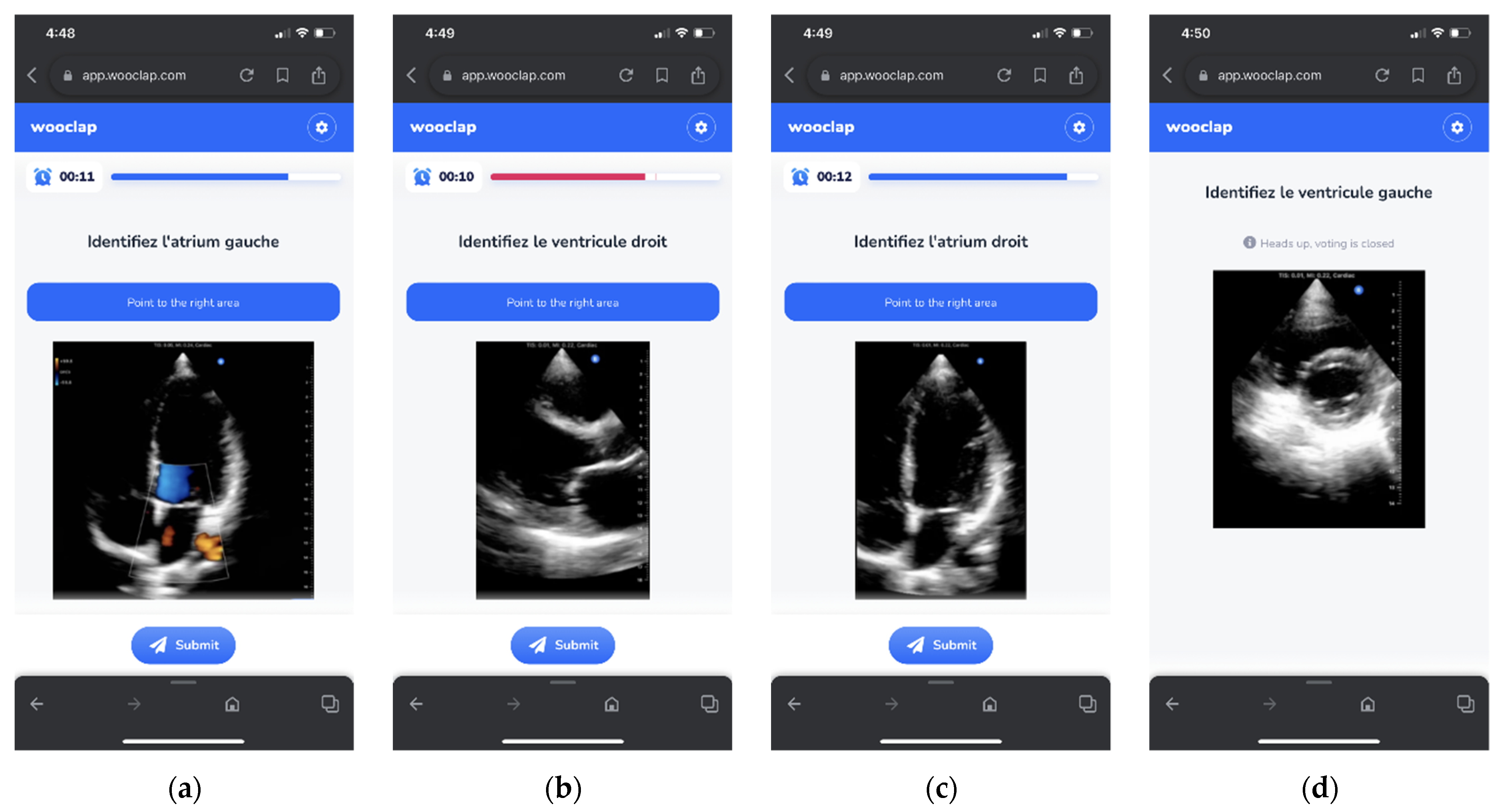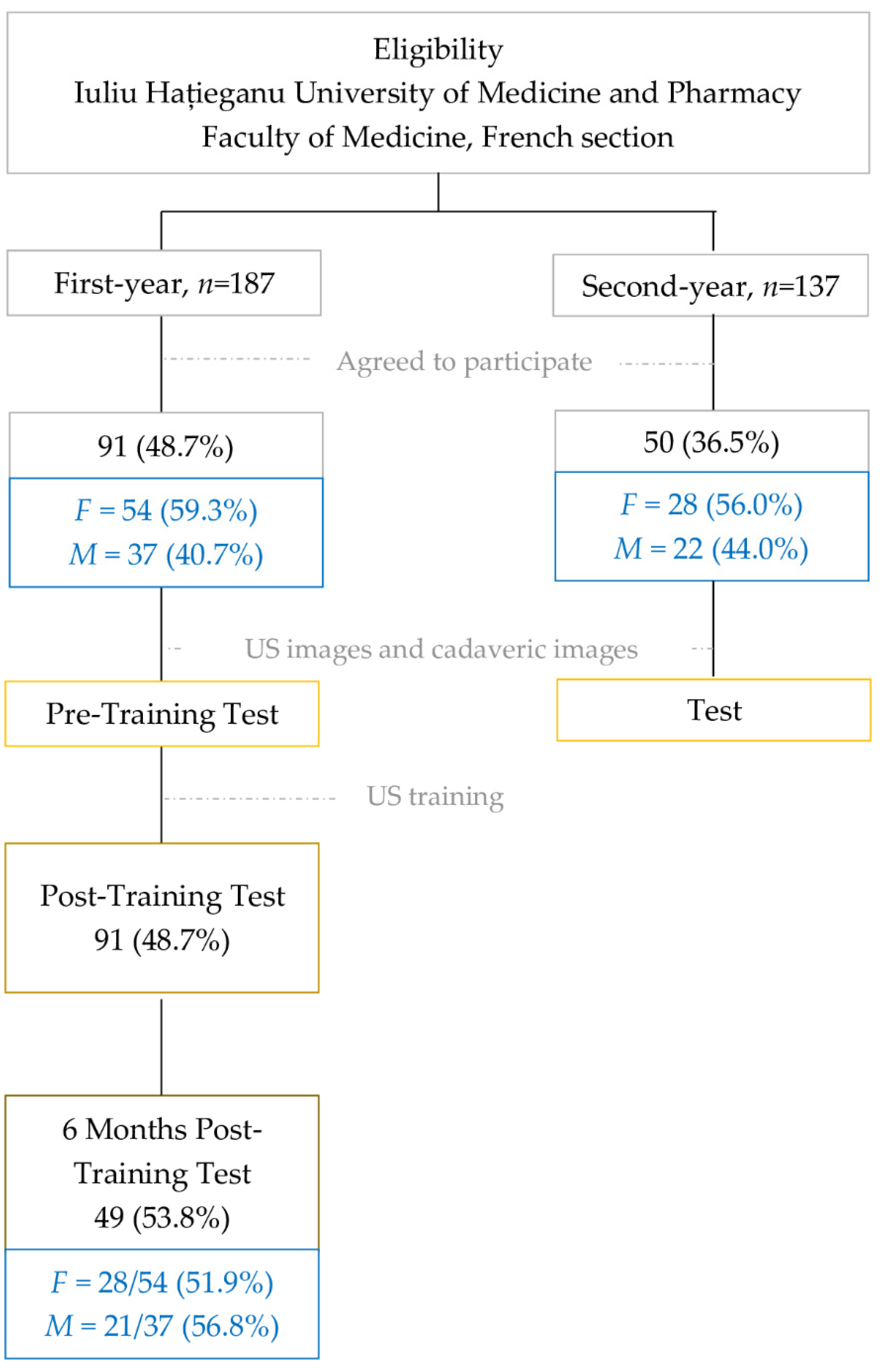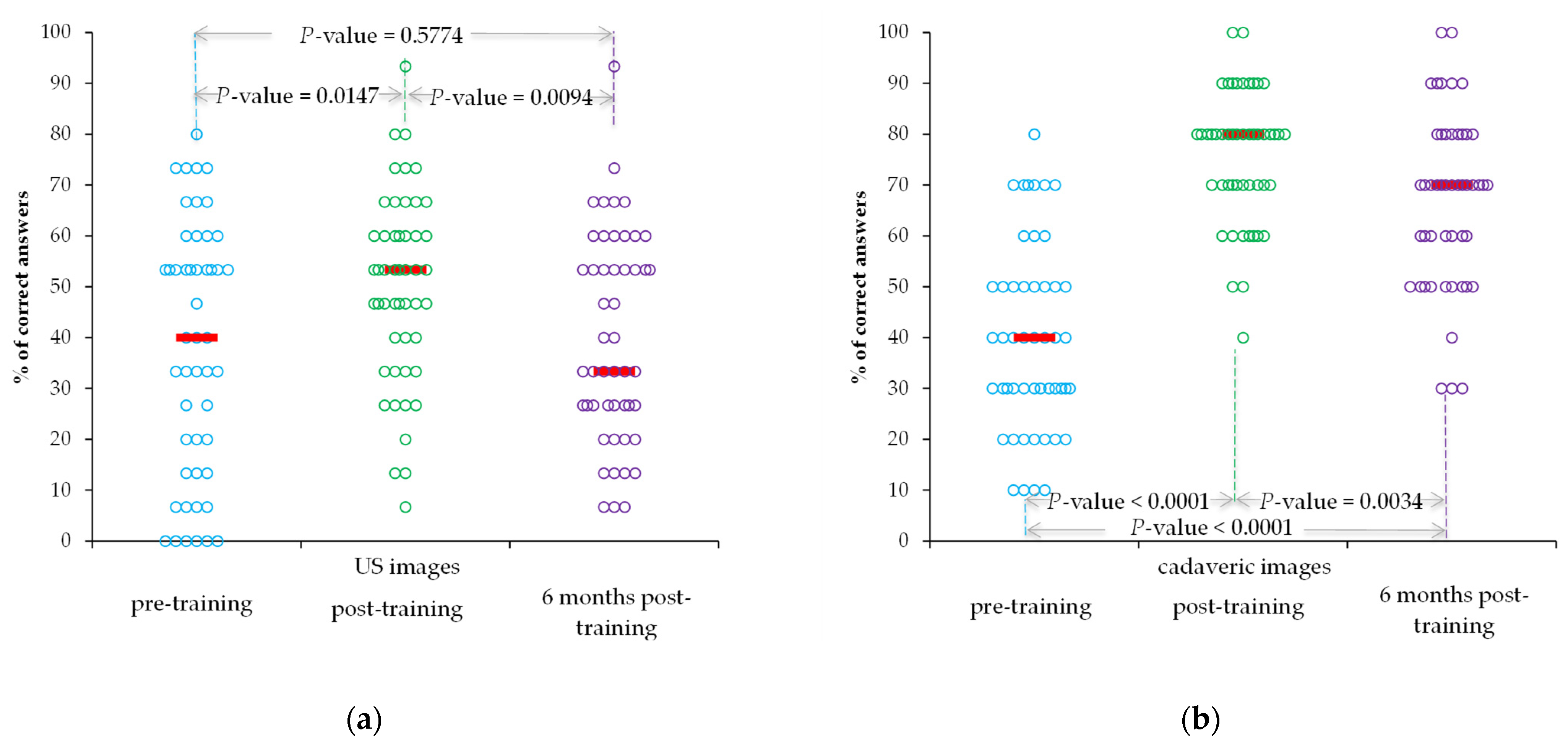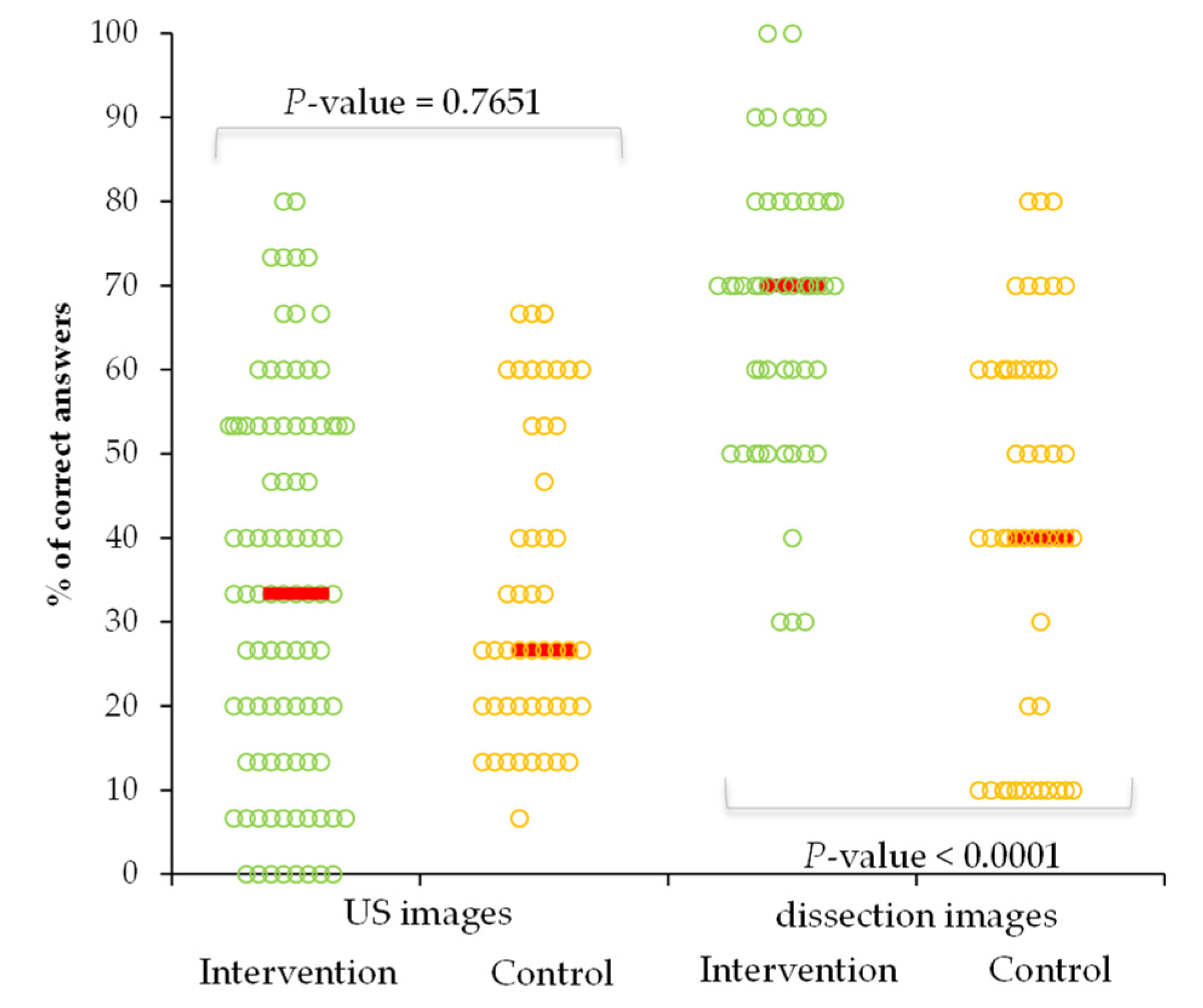Effectiveness of Ultrasound Cardiovascular Images in Teaching Anatomy: A Pilot Study of an Eight-Hour Training Exposure
Abstract
:1. Introduction
2. Materials and Methods
2.1. Ethics and Consent
2.2. Participants Recruitment and Educational Intervention
2.3. Test Structure and Data Collection
2.4. Statistical Analysis
3. Results
4. Discussion
Study Strengths and Limitations
5. Conclusions
Author Contributions
Funding
Institutional Review Board Statement
Informed Consent Statement
Data Availability Statement
Acknowledgments
Conflicts of Interest
References
- Arnold, M.J.; Jonas, C.E.; Carter, R.E. Point-of-Care Ultrasonography. Am. Fam. Physician 2020, 101, 275–285. [Google Scholar]
- Hoppmann, R.A.; Rao, V.V.; Bell, F.; Poston, M.B.; Howe, D.B.; Riffle, S.; Harris, S.; Riley, R.; McMahon, C.; Wilson, L.B.; et al. The evolution of an integrated ultrasound curriculum (iUSC) for medical students: 9-year experience. Crit. Ultrasound J. 2015, 7, 18. [Google Scholar] [CrossRef] [Green Version]
- Bahner, D.P.; Goldman, E.; Way, D.; Royall, N.A.; Liu, Y.T. The state of ultrasound education in U.S. medical schools: Results of a national survey. Acad. Med. 2014, 89, 1681–1686. [Google Scholar] [CrossRef]
- Blackstock, U.; Carmody, K. Transforming Learning Anatomy: Basics of Ultrasound Lecture and Abdominal Ultrasound Anatomy Hands-on Session. MedEdPORTAL 2016, 12, 10446. [Google Scholar] [CrossRef]
- Swamy, M.; Searle, R.F. Anatomy teaching with portable ultrasound to medical students. BMC Med. Educ. 2012, 12, 99. [Google Scholar] [CrossRef] [Green Version]
- Nausheen, F.; Young, C.; Brazil, J.; Dunagan, T.; Bhupathy, R.; Elango, S.; Crowley, J. Confidence Level and Ability of Medical Students to Identify Abdominal Structures After Integrated Ultrasound Sessions. Ultrasound Int. Open. 2020, 6, E7–E13. [Google Scholar] [CrossRef]
- Smith, C.F.; Barfoot, S. Implementation of Ultrasound in Anatomy Education. Adv. Exp. Med. Biol. 2021, 1317, 111–130. [Google Scholar] [CrossRef]
- Prats, M.I.; Royall, N.A.; Panchal, A.R.; Way, D.P.; Bahner, D.P. Outcomes of an Advanced Ultrasound Elective: Preparing Medical Students for Residency and Practice. J. Ultrasound Med. 2016, 35, 975–982. [Google Scholar] [CrossRef]
- Birrane, J.; Misran, H.; Creaney, M.; Shorten, G.; Nix, C.M. A Scoping Review of Ultrasound Teaching in Undergraduate Medical Education. Med. Sci. Educ. 2018, 28, 45–56. [Google Scholar] [CrossRef] [Green Version]
- Allsop, S.; Gandhi, S.; Ridley, N.; Spear, M. Implementing ultrasound sessions to highlight living anatomy for large medical student cohorts. Transl. Res. Anat. 2021, 22, 100088. [Google Scholar] [CrossRef]
- Griksaitis, M.J.; Sawdon, M.A.; Finn, G.M. Ultrasound and cadaveric prosections as methods for teaching cardiac anatomy: A comparative study. Anat. Sci. Educ. 2012, 5, 20–26. [Google Scholar] [CrossRef]
- Royer, D.F. Seeing with Sound: How Ultrasound Is Changing the Way We Look at Anatomy. Adv. Exp. Med. Biol. 2019, 1138, 47–56. [Google Scholar] [CrossRef]
- Patel, S.G.; Benninger, B.; Mirjalili, S.A. Integrating ultrasound into modern medical curricula. Clin. Anat. 2017, 30, 452–460. [Google Scholar] [CrossRef]
- Prosch, H.; Radzina, M.; Dietrich, C.F.; Nielsen, M.B.; Baumann, S.; Ewertsen, C.; Jenssen, C.; Kabaalioğlu, A.; Kosiak, W.; Kratzer, W.; et al. Ultrasound Curricula of Student Education in Europe: Summary of the Experience. Ultrasound Int. Open. 2020, 6, E25–E33. [Google Scholar] [CrossRef]
- Dreher, S.M.; DePhilip, R.; Bahner, D. Ultrasound exposure during gross anatomy. J. Emerg. Med. 2014, 46, 231–240. [Google Scholar] [CrossRef]
- Kefala-Karli, P.; Sassis, L.; Sassi, M.; Zervides, C. Introduction of ultrasound-based living anatomy into the medical curriculum: A survey on medical students’ perceptions. Ultrasound J. 2021, 13, 47. [Google Scholar] [CrossRef]
- Jurjus, R.A.; Dimorier, K.; Brown, K.; Slaby, F.; Shokoohi, H.; Boniface, K.; Liu, Y.T. Can anatomists teach living anatomy using ultrasound as a teaching tool? Anat. Sci. Educ. 2014, 7, 340–349. [Google Scholar] [CrossRef]
- Kapur, J.; Samaraskera, D.; Han, T.; Quek, S.T.; Kanagasuntheram, R.; Ng, Y.K.; Lim, A.; Chong, Y.S.; Yeoh, K.G.; Lee, S.S.; et al. The Role of Ultrasound in teaching Clinical Anatomy to First year Medical Students. MedEdPublish 2016, 5, 29. [Google Scholar] [CrossRef]
- Iwanaga, J.; Singh, V.; Ohtsuka, A.; Hwang, Y.; Kim, H.J.; Moryś, J.; Ravi, K.S.; Ribatti, D.; Trainor, P.A.; Sañudo, J.R.; et al. Acknowledging the use of human cadaveric tissues in research papers: Recommendations from anatomical journal editors. Clin. Anat. 2021, 34, 2–4. [Google Scholar] [CrossRef]
- Aly, I.; Rizvi, A.; Roberts, W.; Khalid, S.; Kassem, M.W.; Salandy, S.; du Plessis, M.; Tubbs, R.S.; Loukas, M. Cardiac ultrasound: An Anatomical and Clinical Review. Transl Res. Anat. 2021, 22, 100083. [Google Scholar] [CrossRef]
- Weissgerber, T.L.; Milic, N.M.; Winham, S.J.; Garovic, V.D. Beyond Bar and Line Graphs: Time for a New Data Presentation Paradigm. PLoS Biol. 2015, 13, e1002128. [Google Scholar] [CrossRef]
- Soucy, Z.P.; Mills, L.D. American Academy of Emergency Medicine Position Statement: Ultrasound Should Be Integrated into Undergraduate Medical Education Curriculum. J. Emerg. Med. 2015, 49, 89–90. [Google Scholar] [CrossRef]
- Ireson, M.; Warring, S.; Medina-Inojosa, J.R.; O’Malley, M.T.; Pawlina, W.; Lachman, N.; Lachman, N.; Narula, J.; Bhagra, A. First Year Medical Students, Personal Handheld Ultrasound Devices, and Introduction of Insonation in Medical Education. Ann. Glob. Health 2019, 85, 123. [Google Scholar] [CrossRef] [Green Version]
- Menegozzo, C.A.M.; Cazolari, P.G.; Novo, F.D.C.F.; Colleoni, R.; Utiyama, E.M. Prospective Analysis of Short- and Mid-term Knowledge Retention after a Brief Ultrasound Course for Undergraduate Medical Students. Clinics 2019, 74, e1087. [Google Scholar] [CrossRef]
- Mizubuti, G.B.; Allard, R.V.; Ho, A.M.; Wang, L.; Beesley, T.; Hopman, W.M.; Egan, R.; Sydor, D.; Engen, D.; Saha, T.; et al. Retenção do conhecimento após treinamento de ultrassonografia cardíaca focada: Estudo-piloto prospectivo de coorte [Knowledge retention after focused cardiac ultrasound training: A prospective cohort pilot study]. Braz. J. Anesthesiol. 2019, 69, 177–183. [Google Scholar] [CrossRef]
- Town, J.A.; Bergl, P.A.; Narang, A.; McConville, J.F. Internal medicine residents’ retention of knowledge and skills in bedside ultrasound. J. Grad. Med. Educ. 2016, 8, 553–557. [Google Scholar] [CrossRef]
- Hospital Healthcare. Available online: https://hospitalhealthcare.com/latest-issue-2017/portable-ultrasound-technology-2/ (accessed on 15 December 2021).
- Zardi, E.M.; Franceschetti, E.; Giorgi, C.; Palumbo, A.; Franceschi, F. Accuracy and performance of a new handheld ultrasound machine with wireless system. Sci. Rep. 2019, 9, 14599. [Google Scholar] [CrossRef] [Green Version]
- Kosmos Platform. Available online: https://kosmosplatform.com/ (accessed on 14 December 2021).
- Tromp, J.; Seekings, P.J.; Hung, C.L.; Iversen, M.B.; Frost, M.J.; Ouwerkerk, W.; Jiang, Z.; Eisenhaber, F.; Goh, R.S.M.; Zhao, H.; et al. Automated interpretation of systolic and diastolic function on the echocardiogram: A multicohort study. Lancet Digit. Health 2022, 4, e46–e54. [Google Scholar] [CrossRef]
- Lal, K.; Gosling, R.; Ghobrial, M.; Williams, G.J.; Rammohan, V.; Hose, D.R.; Lawford, P.V.; Narracott, A.; Fenner, J.; Gunn, J.P.; et al. Operator-dependent variability of angiography-derived fractional flow reserve and the implications for treatment. Eur. Heart J. Digit. Health 2021, 2, 263–270. [Google Scholar] [CrossRef]
- Roelandt, J. The 50th anniversary of echocardiography: Are we at the dawn of a new era? Eur. J. Echocardiogr. 2003, 4, 233–236. [Google Scholar] [CrossRef] [Green Version]




| Metric | Pre-Training | Post-Training | 6 Months Post-Training | p-Value | |
|---|---|---|---|---|---|
| US images test | 33.3 (13.3 to 53.3) {0 to 80} 40 (13.3 to 53.3) {0 to 80} | ||||
| All participants (n = 91) | median (Q1 to Q3) | 53.3 (40 to 66.7) | <0.0001 * | ||
| {min to max} | {6.7 to 93.3} | ||||
| All tests (n = 49) | median (Q1 to Q3) {min to max} | 53.3 (40 to 60) {6.7 to 93.3} | 33.3 (26.7 to 53.3) {6.7 to 93.3} | 0.0397 ** | |
| Cadaveric images test | 30 (20 to 50) {10 to 80} 40 (30 to 50) {10 to 80} | ||||
| All participants (n = 91) All tests (n = 49) | median (Q1 to Q3) {min to max} median (Q1 to Q3) {min to max} | 80 (70 to 80) {20 to 100} 80 (70 to 80) {40 to 100} | 70 (50 to 80) {30 to 100} | <0.0001 * <0.0001 ** | |
| p-value US vs. cadaveric images test | 0.6160 * (a) | <0.0001 * (a) | <0.0001 * (b) | data | |
Publisher’s Note: MDPI stays neutral with regard to jurisdictional claims in published maps and institutional affiliations. |
© 2022 by the authors. Licensee MDPI, Basel, Switzerland. This article is an open access article distributed under the terms and conditions of the Creative Commons Attribution (CC BY) license (https://creativecommons.org/licenses/by/4.0/).
Share and Cite
Haji-Hassan, M.; Călinici, T.; Drugan, T.; Bolboacă, S.D. Effectiveness of Ultrasound Cardiovascular Images in Teaching Anatomy: A Pilot Study of an Eight-Hour Training Exposure. Int. J. Environ. Res. Public Health 2022, 19, 3033. https://doi.org/10.3390/ijerph19053033
Haji-Hassan M, Călinici T, Drugan T, Bolboacă SD. Effectiveness of Ultrasound Cardiovascular Images in Teaching Anatomy: A Pilot Study of an Eight-Hour Training Exposure. International Journal of Environmental Research and Public Health. 2022; 19(5):3033. https://doi.org/10.3390/ijerph19053033
Chicago/Turabian StyleHaji-Hassan, Mariam, Tudor Călinici, Tudor Drugan, and Sorana D. Bolboacă. 2022. "Effectiveness of Ultrasound Cardiovascular Images in Teaching Anatomy: A Pilot Study of an Eight-Hour Training Exposure" International Journal of Environmental Research and Public Health 19, no. 5: 3033. https://doi.org/10.3390/ijerph19053033
APA StyleHaji-Hassan, M., Călinici, T., Drugan, T., & Bolboacă, S. D. (2022). Effectiveness of Ultrasound Cardiovascular Images in Teaching Anatomy: A Pilot Study of an Eight-Hour Training Exposure. International Journal of Environmental Research and Public Health, 19(5), 3033. https://doi.org/10.3390/ijerph19053033








